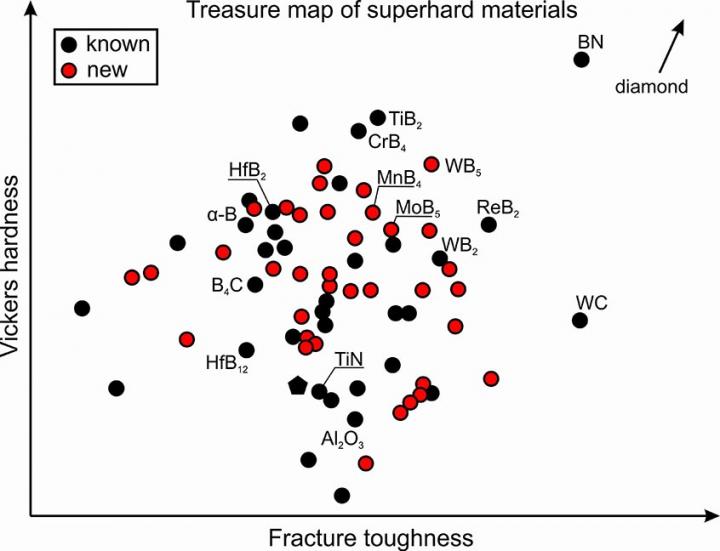Using computational methods, scientists have plotted a highly accurate map to guide the synthesis of new, cheaper materials tough enough for the mining and space industries

Credit: Kvashnin, Skoltech
WASHINGTON, D.C., July 23, 2019 — Diamonds aren’t just a girl’s best friend — they’re also crucial components for hard-wearing industrial components, such as the drill bits used to access oil and gas deposits underground. But a cost-efficient method to find other suitable materials to do the job is on the way.
Diamond is one of the only materials hard and tough enough for the job of constant grinding without significant wear, but as any imminent proposee knows, diamonds are pricey. High costs drive the search for new hard and superhard materials. However, the experimental trial-and-error search is itself expensive.
A simple and reliable way to predict new material properties is needed to facilitate modern technology development. Using a computational algorithm, Russian theorists have published just such a predictive tool in the Journal of Applied Physics, from AIP Publishing.
“Our study outlines a picture that can guide experimentalists, showing them the direction to search for new hard materials,” said the study’s first author Alexander Kvashnin, from the Skolkovo Institute of Science and Technology and Moscow Institute of Physics and Technology.
As fiber optics, with its fast transmission rate, replaced copper wire communications, so too do materials scientists search to find new materials with desirable properties to support modern technology. When it comes to the mining, space and defense industries, it’s all about finding materials that don’t break easily, and for that, the optimal combination of hardness and fracture toughness is required. But it’s tricky to theoretically predict hardness and fracture toughness. Kvashnin explained that although lots of predictive models exist, he estimates they are 10%-15% out off the mark at best.
The Russian team recently developed a computational approach that considers all possible combinations of elements in Dmitri Mendeleev’s periodic table — christened “Mendelevian search.” They’ve used their algorithm to search for optimal hard and tough materials.
By combining their toughness prediction model with two well-known models for material hardness, the scientists’ algorithm learned which regions of chemical space of compounds were most promising for tough, hard phases that could be easily synthesized.
Results were plotted on a “treasure map” of toughness vs. hardness, and the scientists were impressed by what they saw. All known hard materials were predicted with more than 90% accuracy. This proved the search’s predictive power, and the newly revealed combinations are potential treasures for industry.
Kvashnin explained he is part of an industrial project devoted to new materials for drilling bits, where experimentalists are now synthesizing one of these hard material treasures — tungsten pentaboride (WB5).
“This computational search is a potential way to optimize the search for new materials, much cheaper, faster and quite accurately,” said Kvashnin, who hopes that this new approach will enable the speedy development of new materials with enhanced properties.
But they aren’t stopping there with the theory. They want to use their modern methods and approaches to pin down the general rules for what makes hard and superhard materials among the elements to better guide researchers of the future.
###
The article, “Computational discovery of hard and superhard materials,” is authored by Alexander G. Kvashnin, Zahed Allahyari and Artem R. Oganov. The article will appear in the Journal of Applied Physics on July 23, 2019 (DOI: 10.1063/1.5109782). After that date, it can be accessed at http://aip.
ABOUT THE JOURNAL
The Journal of Applied Physics is an influential international journal publishing significant new experimental and theoretical results of applied physics research. See http://jap.
Media Contact
Larry Frum
[email protected]
Related Journal Article
http://dx.



